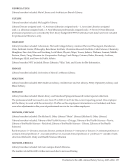University Library Questionnaire and Instructions · 139 8 SBS, or AREA) to describe that position. If you cannot determine which sub-code to use, please use the SSPEC code. These codes were formerly collected every 5 years. Use these codes to indicate non- supervisory main and/or branch library staff who specialize in one of the subject areas (either a sub-field, or the entire area) indicated in the “job codes” section. Do not add codes for staff in these positions who have broader, other, or mixed subject responsibilities (e.g. more than one field specialty) but do include subject specialists who also have some (i.e. 50% or less) general or other assignments. NOTE: The AREA sub-code captures the responsibilities of library professionals with country, geographic area or language specialization. Law and Health Sciences librarians are not included under the AREA sub-code unless these individuals have a country, geographic area or language specializations. 5.Please indicate “Sex” with the letter M or F, indicating male or female, respectively. 6. “OEOCat” minority status code, for U.S. university libraries only, should be indicated with one of the following code numbers. (Leave blank if a Canadian library): 1 =Black 2 =Hispanic 3 =Asian or Pacific Islander 4 =American Indian or Native Alaskan 5 =Caucasian/Other 7. “YrsExp,” or total years of professional experience. For most professional staff members this will mean counting the years since the MLS degree was awarded. When counting, do not subtract interim periods when an individual was not engaged in professional library employment if these periods are short in relation to the overall professional career. Count an academic year contract period as a full year. Be sure to include professional experience in previous positions and in other institutions. The figure should be rounded off to the nearest whole number for example, a position with 14.5 years of experience would appear as 15. 8. Indicate “Rank” using the following system of codes: 0 The library director. Some systems also use 0 for assistant and/or associate directors. 1 Lowest level in the rank structure, such as an entry-level position. 2-8 Successively higher levels for example, 5 indicates a higher rank than 2. 9 Rank cannot be determined, or, the individual is outside the organization’s rank structure. NOTE: These codes are meant to be guides only. Do not recode your rank system into an 8 level system if your rank system does not have eight levels. Please code each employee with his or her actual rank at your institution. When coding the library director as "0", do not add or subtract a level to or from your ranking system.










































































































































































